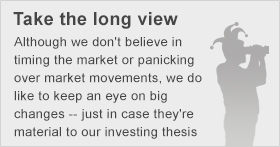Filed under: Investing

Factory orders fell slightly in May, slumping 0.5% after a 0.7% increase in April. Unfortunately, this doesn't corroborate the view many investors developed yesterday -- that the U.S. economy is in firm recovery mode -- a view developed after impressive auto sales and strong numbers from the manufacturing sector sent the stock market soaring. Wednesday's gains were more muted, as the Dow Jones Industrial Average added 20 points, or 0.1%, to close at 16,976. Though blue chips ended just shy of the 17,000 level, the index finished at a record closing level nonetheless.
One of the stocks helping the Dow to its record close was Wal-Mart , which tacked on 0.5% by the ring of the closing bell on Wednesday. Wal-Mart might not be the most explosive or exciting stock you've ever heard of (at least I sincerely hope it isn't), but it's a solid investment option for conservative investors. If you become physically ill at the prospect of risk, stay inside, eat healthily, and consider buying some Treasuries. If you merely dislike risk but realize it's a prerequisite for any type of meaningful return, Wal-Mart's not a bad stock to consider. Trading at just 15 times earnings and dishing out a reliable 2.5% annual dividend, you can own a small piece of one of the largest public companies in the world. The day people stop needing clothing, groceries, electronics, furniture, and $4 DVD bins, you can start worrying. However, you'll probably be more concerned with the zombie apocalypse or alien invasion at that point in time.
King Digital Entertainment , next to the remarkable post-IPO performance of GoPro, has been one of the stock market's hottest performers in the last week. Stringing on a fifth straight day of gains, shares of the Candy Crush Saga game developer jumped 6.3% on Wednesday, as the stock came to rest more than 33% above its price just one week ago. Unusually bullish options activity last Friday began the rally in earnest, as Wall Street took notice and bid the stock 5% higher. Those oddly prescient investors were immediately rewarded on Monday, when King Digital posted the best-performing day in its history as a public company, roaring 15% higher on a JPMorgan analyst applauded the company, citing upcoming game launches and the possibility of share buybacks or a dividend being issued in the coming year.

American Airlines doing what it does best. Source: American Airlines
While Wal-Mart was up incrementally and King Digital posted massive gains today, shares of American Airlines didn't even approach breakeven levels, shedding 4.4% on Wednesday. Stocks in the airline industry -- because they are relatively few in number and because airlines boast a business model that's evaded disruption for about a century -- are often highly correlated to one another. Today was no different: Delta Air Lines reported disappointing international travel business in June, sending shares of American Airlines and other global providers skidding as investors braced for similar results. The World Cup is partly to blame for decreased business travel in Latin America last month, as the region turns its eyes to Brazil to root against Belgium -- I mean, to cheer on their home countries.
Top dividend stocks for the next decade
The smartest investors know that dividend stocks simply crush their non-dividend-paying counterparts over the long term. That's beyond dispute. They also know that a well-constructed dividend portfolio creates wealth steadily, while still allowing you to sleep like a baby. Knowing how valuable such a portfolio might be, our top analysts put together a report on a group of high-yielding stocks that should be in any income investor's portfolio. To see our free report on these stocks, just click here now.
The article Dow Hits Record, King Digital Rallies Higher, American Airlines Slumps originally appeared on Fool.com.
John Divine has no position in any stocks mentioned. You can follow him on Twitter, @divinebizkid , and on Motley Fool CAPS, @TMFDivine . The Motley Fool owns shares of JPMorgan Chase. Try any of our Foolish newsletter services free for 30 days. We Fools don't all hold the same opinions, but we all believe that considering a diverse range of insights makes us better investors. The Motley Fool has a disclosure policy.Copyright © 1995 - 2014 The Motley Fool, LLC. All rights reserved. The Motley Fool has a disclosure policy.
Read | Permalink | Email this | Linking Blogs | Comments






















































